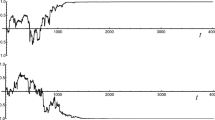Abstract
A brief review is given of the continuous spontaneous localization (CSL) model, in which a classical field interacts with quantized particles to cause dynamical wavefunction collapse. One of the model's predictions is that particles “spontaneously” gain energy at a slow rate. When applied to the excitation of a nucleon in a Ge nucleus, it is shown how a limit on the relative collapse rates of neutron and proton can be obtained, and a rough estimate is made from data. When applied to the spontaneous excitation of 1s electrons in Ge, by a more detailed analysis of more accurate data than given previously, an updated limit is obtained on the relative collapse rates of the electron and proton, suggesting that the coupling of the field to electrons and nucleons is mass proportional.
Similar content being viewed by others
REFERENCES
D. Bohm and J. Bub, Revs. Mod. Phys. 38, 453 (1966).
P. Pearle, Phys. Rev. D 13, 857 (1976). For more on this pre-GRW work, see P. Pearle, in Sixty-Two Years of Uncertainty, A. Miller, ed. (Plenum, New York, 1990), p. 193.
G. C. Ghirardi, A. Rimini, and T. Weber, Phys. Rev. D 34, 470 (1986); Phys. Rev. D 36, 3287 (1987); Found. Phys. 18, 1 (1988).
P. Pearle, Phys. Rev. A 39, 2277 (1989). G. C. Ghirardi, P. Pearle, and A. Rimini, Phys.Rev. A 42, 78 (1990). For reviews, see G. C. Ghirardi and A. Rimini, in Sixty-Two Years of Uncertainty, A. Miller, ed. (Plenum, New York, 1990). G. C. Ghirardi and P. Pearle, in Proceedings of the Philosophy of Science Foundation 1990, Vol. 2, A. Fine, M. Forbes, and L. Wessels, eds. (PSA Association, MI, 1992), pp. 19, 35.
F. Karolyhazy, Nuovo Cimento 42A, 1506 (1966). P. Pearle and E. Squires, Found. Phys. 26, 291 (1996).
P. Pearle, Phys. Rev. A 59, 80 (1999).
J. R. Clauser, private communication.
A. Zeilinger, private communication.
E. J. Squires, Phys. Lett. A 158, 432 (1991).
Q. Fu, Phys. Rev. A 56, 1806 (1997).
P. Pearle and E. J. Squires, Phys. Rev. Lett. 73, 1 (1994).
B. Collett, P. Pearle, F. Avignone, and S. Nussinov, Found. Phys. 25, 1399 (1995).
H. S. Miley, F. T. Avignone III, R. L. Brodzinski, J. I. Collar, and J. H. Reeves, Phys. Rev.Lett. 65, 3092 (1990).
R. Penrose, in Quantum Concepts in Space and Time, R. Penrose and C. J. Isham, eds. (Clarendon, Oxford, 1986), p. 129; The Emperor's New Mind (Oxford University Press, Oxford, 1992); Shadows of the Mind (Oxford University Press, Oxford, 1994).
L. Diosi, Phys. Rev. A 40, 1165 (1989); G. C. Ghirardi, R. Grassi, and A. Rimini, Phys.Rev. A 42, 1057 (1990); Ref. 6.
P. Pearle, Found. Phys. 12, 249 (1982).
J. I. Collar, Ph.D. thesis (University of Southern California, Los Angeles, 1992).
E. Garcia et al., Phys. Rev. D 51, 1458 (1995).
J. Morales et al., Nucl. Instr. Meth. A 321, 410 (1992).
A. K. Drukier et al., Nucl. Phys. B (Proc. Suppl.) 28A, 293 (1992).
Y. Aharonov et al., Phys. Rev. D 52, 3785 (1995).
C. E. Aalseth et al., Nucl. Phys. B (Proc. Suppl.) 48, 223 (1996).
J. M. Blatt and V. E. Weisskopf, Theoretical Nuclear Physics (Wiley, New York, 1960), p. 595.
V. E. Weisskopf, Theoretical Nuclear Physics (Wiley, New York, 1960), p. 625 et seq.
R. D. Lawson, Theory of the Nuclear Shell Model (Clarendon, Oxford, 1980).
J. Joubert, F. J. W. Hahne, P. Navratil, and H. B. Geyer, Phys. Rev. C 50, 177 (1994), and references therein.
Rights and permissions
About this article
Cite this article
Pearle, P., Ring, J., Collar, J.I. et al. The CSL Collapse Model and Spontaneous Radiation: An Update. Foundations of Physics 29, 465–480 (1999). https://doi.org/10.1023/A:1018879201822
Issue Date:
DOI: https://doi.org/10.1023/A:1018879201822




